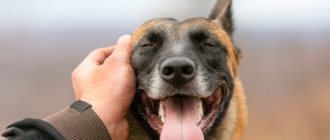Many thousands of years ago, man tamed a dog, making a friend out of his once fierce enemy - the wolf. Pithecanthropus managed to take the place of the owner, the leader of the dog tribe. And over a long time of living together, friendly relations between man and dog developed. Pithecanthropus saw in his animal primarily a servant, a watchman and sometimes a breadwinner and assistant in the hunt. By observing pets, people learned to understand the psychology of a dog, and human behavior changed noticeably. But the centuries-old traditions of the wolf family still live in the descendants of primitive dogs.
The psychology of dog behavior is based on conditioned and unconditioned reflexes. The struggle for leadership is also inherent in dogs. These remnants of pack life are alive in modern dogs. A person who is inexperienced in raising a dog, when purchasing an animal, does not think about the fact that perhaps the pet itself will raise it “for itself and its own interests.”
Features of dog psychology
Any owner of a four-legged friend needs to understand that a dog is, first of all, an animal with its own psyche and special behavior that is different from that of a human. So, dog psychology is based on:
- Natural instincts characteristic of all living beings. Instincts are dominant.
- Reflexes or reactions of the body to environmental influences.
- Gained life experience: dogs can be successfully trained and raised.
Take my raincoat please
Are we, with our love of anthropomorphism, also mistaken about dogs? Yes. Take four-sleeve dog clothes for example. Many dog owners have noticed that their pets are reluctant to go outside in bad weather, and have concluded: dogs do not like rain.
What does it mean? The dog probably doesn't like being wet by the rain, just like we don't like it. But is this true? Is your dog excited and wagging its tail when you take the raincoat out of the closet? Don’t rush to celebrate: maybe she just understands that the appearance of a raincoat heralds a long-awaited walk. Does your dog squirm, tuck its tail, and twist its head when you put a raincoat on it? This discourages you, but you are in no hurry to doubt that you are right. What does a dog look like when he gets wet? Is he dirty? And at the same time he shakes himself off with delight? Unclear.
The natural behavior of wild canids may help answer the question of what exactly a dog thinks about a raincoat. Both dogs and wolves have a “raincoat”, which is an integral part of the animal - wool. It is quite enough; when it starts to rain, wolves seek shelter rather than try to build an improvised raincoat.
In addition, dog clothing tightly fits the back, chest, and sometimes the head of the animal. The wolf experiences pressure on these parts of the body when another wolf asserts its power over it or an older relative “punishes” it for disobedience. Dominant individuals often pin subordinates to the ground, grasping their muzzle with their jaws. This is called educational nipping, and may be why muzzled dogs appear unusually submissive.
A dog that pins its fellow dog to the ground is a dominant dog, and a subordinate dog in such a case experiences inevitable pressure. This is probably what the raincoat evokes. Therefore, the main feeling that a dog experiences when wearing a raincoat is not protection from moisture. Rather, the raincoat gives her the confidence that a higher-ranking individual is nearby. A dog dressed in a raincoat may obediently go outside, but not because it likes wearing it, but because it has been forced into a subordinate role. Of course, in the end she won't get wet, but that's our concern, not the dog's.
To avoid this kind of mistake, you need not to “humanize” the dog, but to correctly interpret its behavior. In most cases, everything is simple: the owner must ask the dog what it wants. You just need to know how to translate the answer.
Territory defense
Many animals, including dogs, sense their territory and defend its borders.
A guard dog will keep order in the area, be attentive to strangers, barking to notify you of the appearance of uninvited guests. A street dog will guard the yard, and a domestic dog will guard the apartment, which it perceives as personal possessions. Additionally! Within the yard or room for the dog, you need to create an individual place where the animal would feel safe.
Learning to understand your pet
Before raising the question of the need to correct the dog’s behavior in one direction or another, every owner should understand his pet, what provoked his behavior and only then make a decision on how to correct it, correcting it in one direction or another.
- Joy – the manifestation will be the same for both an adult dog and a puppy. The dog will jump on the person, lick the face and hands, run merrily and bark around the owner. Her behavior can also manifest itself as an invitation to play; the animal will bring toys.
- Goodwill. The physiological foundations of the animal’s behavior in this case are inherent in its character from the very beginning - the dog’s goodwill is determined not only by the conditions of detention, nutrition or other external factors, but also by its breed and character. The dog shows its disposition and goodwill by wagging its tail, the animal’s body is relaxed, its ears are somewhat raised, but rather express curiosity.
- Dominance. The dog shows its dominant inclinations clearly and clearly - it is not difficult to understand them. First of all, this is expressed in increased sexual activity, jumping on the owner and family members as during estrus or rutting. If an animal takes toys or food from other dogs, it is a clear leader and training, an attitude of subordination to the owner, and a correct understanding of the pet’s physiology by the person himself will help correct this behavior.
- Aggression. In this case, the dog, as a natural aggressor, due to its character, breed or conditions of detention, will display aggressive behavior by loudly barking and throwing towards the owner or other animals, and attempting to bite. In this case, a training course is required - it may differ from the standard program, but if there is a need, then the use of other methods of influencing the animal, for example, taking sedatives.
- Readiness to attack - in this case, the animal’s behavior may resemble the behavior of a friendly dog, but... Its behavior has its own differences - the dog will wag its tail with a smaller amplitude, holding it up, the body will be tilted forward, the front paws will be spread wide apart.
- Showing submission. The behavior of dogs in this case involves demonstrating their belly. The behavior of a dog on the street or at home when meeting an adult, larger individual will be unambiguous - the animal allows itself to be sniffed, lies on its stomach and shows its stomach as its most unprotected place. This behavior is typical of young dogs and puppies that are not capable or cannot, for one reason or another, take a dominant position in the pack.
- Fatigue. For every owner to understand their pet, simply observe its behavior - the physiology of the behavior of a tired animal is similar to the behavior of a person. Their behavior will manifest itself in slow and heavy movements, a constant desire to sit down or lie down.
- Fear and stressful situations. Thus, the behavior of an animal in a state of stress can vary - trembling in the body, attempts to escape or hide behind the owner’s legs, manifestation of aggression, even involuntary urination. Just take the animal home and calm it down. The main thing to remember is that you should not lisp or pet an animal in a state of fear, as in the future this may form an inadequate attitude towards the source of fear and stress.
Types of behavior
Each dog tends to exhibit certain stereotypies. The following types of behavioral reactions can often be observed:
- Communication: interactions with relatives. This includes both marking and demonstration actions.
- Sexual behavior is actions involving an individual of the opposite sex for the purpose of mating and procreation.
- Hunting - searching and tracking prey, as well as protective, that is, preserving the catch.
- Comfortable - behavior aimed at taking care of oneself. For example, the animal licks itself, washes and cleans its paws, shakes water or debris from its fur, stretches, etc.
Struggle for leadership
The psychology of dogs differs (regarding leadership) between animals of different sexes. Males in a wild pack always conflict for the right to be the leader. The same applies to domestic dogs. During the maturation period, starting from the age of seven months, the male dog will show its leadership qualities. Be it pulling on the leash and trying to be the first to run into the apartment or ordinary disobedience to orders. The pet will always look for weaknesses in the owner’s character. It is important to strictly suppress disobedience and insubordination during this period. That is, you need to suppress the dog’s desire for dominance, thereby establishing your dominance in the family. Female dogs also have a struggle for leadership, only with less pressure and aggression.
Parental care of puppies
Puberty in males begins at 6 and ends at 12-18 months, females are ready to give birth to babies from 1-1.5 years. When babies appear, parents are fully dedicated to caring for and training the puppies.
The dominant role is given to the female: she feeds and warms them, licks them, protects and controls their movements, protecting them from injury. As the offspring grow, the male shows the children how to hunt, teaches them to run and overcome various obstacles.
Additionally! If the owner does not plan to breed, the pet is usually castrated or sterilized.
Dogs are very caring parents
Zoopsychology
Animal psychology is a large branch of psychology that studies the manifestations and patterns of the psyche of animals. This is reflected in the study of their perceptions, emotions, external behavior and relationships with relatives and people.
Science also engages in comparative studies of the psyche of animals and humans. In the context of this article, we can talk about a special branch in science - animal psychology of dogs: training and education.
Recommendation! A specialist, an animal psychologist or a dog handler, can help you learn more about the animal’s psyche or correct its behavior.
Special literature
In an effort to teach a person to understand their dog, many books and articles have been written. They reveal in detail the reasons for a particular behavior of a pet. In order to understand the needs of your pet, you can read the book “Dog Psychology. Fundamentals of Dog Training" by American veterinarian and writer Leon Fradley Whitney (1894-1973). This scientist devoted his entire life to biology and wrote several publications based on his own studies of various animals and people. But the author’s greatest achievement, in his own opinion, is this book about the behavior and habits of pets. The psychology of dogs has been studied very well since the time of academician Ivan Pavlov; on the basis of this knowledge, education and training systems are developed.
The psychology of dogs, the basics of their behavior, have been studied by humans for many years. All animal behavior is determined by reflexes, genetics and habits. Service dogs, bred for centuries to protect human property, inherit certain working qualities at the genetic level.
Dog personality
Each dog has its own set of innate and acquired qualities that make it unique. Basic factors such as heredity and the specifics of the external environment determine temperament and lay down the character of the animal. Under their influence, the pet can be affectionate and friendly or timid and even aggressive. With the help of educational measures, the owner can correct the dog's behavior to a certain extent.
Attention! The individual characteristics of the dog directly affect the success of training.
When is it necessary to correct dog behavior?
If the owner is unable to correct the behavior of his aggressive pet and the former poses a serious threat to humans, contacting specialists and taking a course of training and behavior correction will help solve the problems that have arisen. First of all, you should show your pet to a veterinarian and a dog handler, a zoologist - they will help determine the root cause of deviations in the animal’s behavior, its aggression, drawing up a correction program.
Thus, specialist zoologists note that correction of a dog’s behavior can be carried out with the help of a training course, a program for eliminating the root causes and correction of the animal’s behavior, drug treatment, and even castration.
In practice, dog handlers identify the following stages of correcting an animal’s behavior.
- First of all, it is worth building a relationship with a dog in tandem Human - Dog, replacing the previously existing one, Dog - Human, when your pet in the house defended its dominant role as the leader of the pack.
- Next, with the help of any sound signal, namely a sound, but not a force blow, stop any inappropriate behavior of the animal. This could be a whistle or a loud clap of your hands - most importantly, without the use of physical force, which can aggravate the situation and the aggression of the pet.
- Further, every correct action or behavior of the animal should be encouraged - this can be a treat, as well as stroking and praising the pet.
- To fully consolidate the results obtained, take a training course from an experienced dog handler. We correct the animal’s behavior in this case by not simply transferring the dog to the care of a dog handler, but by working with it in pairs, attending every training lesson, completing every task of the pet’s correction and training course. This will not only consolidate the results obtained, but will also build a trusting, strong relationship between the dog and the owner.
Features of dog emotions
Four-legged pets exhibit many of the well-known emotional reactions. Canines can feel:
- Joy, which is usually manifested by a wagging tail and a general excited state. This is how they react to fellow friends or a significant person, to pleasant events - feeding and walks.
- Sadness: manifests itself in lethargic and depressed behavior, decreased appetite, drooping head and tail. The animal is very sad when alone and without communication with its owner.
- An analogue of shame, or fear of punishment. If a pet is naughty, it hides, tries not to look the person in the eyes, lowers its ears and lies down, and begins to whine.
- Jealousy. In the presence of another animal or a small child, the pet tries to attract the owner's attention to itself. However, dog jealousy has not been scientifically proven.
- Anger. If a dog or owner is attacked or their personal territory is encroached upon, the animal instinctively defends itself - growls, barks, presses itself to the floor, demonstrating its readiness to attack.
Four-legged comrades are friendly not only towards their relatives, but also towards humans
Mutual understanding between owner and pet
Not only the owner can learn to understand the behavior of his dog. Pets living side by side with people themselves quite quickly remember individual phrases and various intonations.
How a dog sees and understands a person
When communicating with a four-legged animal, it is recommended to use 3 intonations:
- threatening, used in punishment;
- an order, pronounced in a stern and clear voice during training;
- affectionate, necessary to encourage desired actions.
The dog learns to communicate with a person by correlating intonations with subsequent events. He remembers his habits, individual phrases and gestures. The speed of learning depends on the possible benefits. Because of this, the words “Eat” and “Walk” are remembered much faster than the menacing “Ugh”, which involves urgently spitting out a delicious piece of food from the trash.
How can a person understand an animal?
When raising a four-legged pet, it is very important to take into account his feelings. A dog’s behavior can be understood by 2 types of signals:
- acoustic (barking, howling, growling, whining);
- visual (various signs given through body language).
The first group of signals is classified as verbal communication, and the second group is non-verbal. Depending on their combination, you can determine the feelings experienced by the animal.
Relationship with a person
Dogs have tender feelings towards people, quickly become attached and perceive the owner as their leader. They require care and attention, they want to be significant and needed. Being alone is not only boring for a dog, but also uncomfortable, since these are social creatures and it is common for them to live in a pack.
It is especially difficult for a puppy to be alone without a person who is essentially a parent. In cases where the pet must be alone in the room for some time, food and water are left for it, as well as dog toys for entertainment.
Important ! When leaving home, it is extremely undesirable to leave the animal for a long period of time - no more than 8 hours.
How to determine the degree of trust?
To find out the degree of trust and obedience to the owner, you can put the animal on its back. A dog that is submissive and confident in a person will allow itself to be laid on its shoulder blades. An obstinate dog will jump up, growl and resist.
It is necessary to suppress disobedience, but in no case should one resort to brute force. A person in a relationship with his pet must play a dominant role.
Psychology of breeds
Every dog is individual, but specific breeds are characterized by some predictability in behavior. For example:
- Indoor decorative options are small in size, they are cheerful, active and inquisitive.
- Companions are loyal and friendly four-legged comrades who are happy to make contact with people.
- Service dogs are protective dogs. Observant, protect a person and his family, clearly know their place; need guidance from the owner. They can be aggressive towards strangers and other animals.
- Hunting: characterized by mobility, endurance and high intelligence.
The meaning of things
Different animals see objects around them differently. A dog who looks around the room does not at all consider himself surrounded by a person’s things - all these are objects of his world. Our ideas about what this or that object is intended for may or may not coincide with a dog’s. The meaning of things is determined by what we do with them (von Uexküll called this “functional tone”). A dog may be indifferent to chairs, but if you teach him to jump on them, the chair becomes something to sit on. Subsequently, the dog may independently discover that there are other things intended for sitting: a couch, a pile of pillows, or, for example, a person’s lap.
So, we begin to understand in what ways the ideas about the world of dogs and humans are similar and in what ways they are different. For dogs, many objects in the surrounding world are associated with food - much more than for people. Moreover, they distinguish “functional tones” that do not exist for us - for example, things that can be tastefully rolled on. If we are not children and are not inclined to such games, then the number of such objects tends to zero for us. And on the contrary, a huge number of things that have a strictly defined meaning for us (forks, knives, hammers, pushpins, fans, watches, etc.) have no (or almost no) meaning for dogs.
So, there is no hammer for a dog. It means nothing to her, at least until it is associated with another, meaningful object (for example, the owner uses it; the cute dog who lives down the street urinated on it; it has a wooden handle that can be chewed on).
When the umwelts of a dog and a person collide, then, as a rule, people do not understand what their pets are doing. For example, a person quite seriously states that his dog knows that he has nothing to do on the bed. A person can even buy a special dog bed and order the dog to go lie down there. Usually the dog obeys. The person feels satisfied. Still, another step towards mutual understanding has been taken.
But is it? Many times, returning home, I found a crumpled, still warm bed and realized that either my dog had just been lying there, joyfully greeting me on the threshold, or some unknown invisible alien. We easily formulate: a bed is intended for a person, a dog bed is for a dog. A human bed is a place to rest and may contain expensive linens and a variety of pillows. It wouldn’t even occur to us to sit on a dog bed that cost us (comparatively) little and is strewn with chewed up toys.
What about the dog? She doesn't see much difference between her bed and ours, but ours is much more attractive. After all, a bed smells like a person, and a dog bed smells like something that the master happened to have at hand. The bed is where we spend some time; Sometimes there are crumbs scattered and clothes lying around. Of course, the dog will prefer our bed to his bed! She doesn't know why we perceive this place differently. Of course, a dog can remember that a human bed is something special if he is regularly scolded for lying on it. But then he will understand not the difference between his bed and our bed, but rather the difference between the places where he can and cannot lie unhindered.
In the dog world, a bed does not have a “functional tone.” Dogs sleep where they can, and not where we would like them to. For relaxation, they choose places where they can lie down comfortably, where it is not hot or cold, there are relatives and it is safe. Almost any flat surface in the house meets these requirements. Design a corner to suit your dog's tastes, and your pet will likely find it just as desirable as a bed.
Psychology and education
Training plays an important role in developing the character and behavior of animals. The dog’s psyche is flexible and, like in humans, it is formed from early childhood: the appropriate age to begin training is 1-2 months old.
The dog must respond to its name and know the basic commands: “Come to me”, “Give me a paw”, “Walk”, “Nearby”, “Sit”, “No” and others. A dog learns by looking at the behavior of others, so the owner is the main example it follows. However, the animal does not just imitate, but uses its accumulated experience. It is on this basis that learning is built: positive reactions are reinforced, negative reactions are prohibited.
Important! It is almost impossible to teach basic commands to an adult.
How a dog's character is formed
A dog's behavior is established from birth. Despite this, over time it undergoes some changes as a result of external factors.
Depending on congenital characteristics
Congenital characteristics depend on the breed. They are fixed during selection and passed on to future generations by inheritance. Most terriers are characterized by hyperactivity and slight excitability, while pugs and English bulldogs are characterized by laziness and calmness. Golden retrievers and Labradors are the kindest creatures in the world, not suitable for home guarding, and Caucasian Shepherds and Rottweilers are their complete opposites.
An equally important aspect is temperament. The form of training the animal depends on it, since each type needs a specific approach:
- Melancholic people. The most reserved and cowardly type, requiring a lot of strength and patience.
- Phlegmatic people. They pick it up on the fly, but have great difficulty switching to new commands.
- Cholerics. They quickly perceive new information conveyed in a playful form, but are constantly distracted by any stimuli.
- Sanguines. Ideal students who love training. They are easy to motivate and almost impossible to distract from their studies.
When choosing a four-legged friend, it is very important to evaluate the puppy's behavior. Dominant individuals constantly initiate games and push less agile kids in the right direction. If you have little experience in raising four-legged pets, give preference to a more modest puppy, sitting calmly in a corner.
Depending on your upbringing
Aggression and other undesirable character traits appear due to lack of socialization and training. The most common problems for novice dog breeders are excessive permissiveness, lack of punishment, or, conversely, excessive cruelty.
Any pet, regardless of its size, must know basic commands and rules of behavior in society. If there is no result for a long time, you should contact a dog handler. Taking a training course under the guidance of an experienced trainer will help instill discipline and reduce the possible danger of the dog to others.
Facts about dog psychology you didn't know
Some common facts about dogs are myths.
What else can animal psychologists tell you about dogs: 5 interesting facts:
- From a psychological point of view, animals do not feel guilty.
- Dogs know how to make friends.
- Pets can calm themselves and others.
- Dogs are capable of empathy and compassion.
- Dogs are very smart: they have excellent memory, notice relationships between events and can make predictions.
The concept of “animal psychology of dogs” needs to be studied not only by specialists working in this field, but also by owners of four-legged animals. It will be much easier for the owner to take care of his pet, it will be easier to train and train him if he is well acquainted with the structure of the dog’s psyche.
In someone else's skin
To be able to recognize the essential elements of an animal's umwelt is, in essence, to become an expert on ticks, dogs, people, and so on. This is how we can close the gap between what we think we know about dogs and what they really are.
We can try to assimilate the umwelt of another animal, to incarnate into the animal (bearing in mind the limitations imposed by our sensory system). It's an amazing thing to spend a day being as tall as a dog. Sniffing (even with our less-than-perfect noses) the objects we encounter throughout the day fundamentally changes the way we think about familiar things.
Now pay attention to the sounds in the room where you are - sounds that you are used to and that you do not usually listen to. So, with some effort, I hear the noise of a fan in the corner, the hum of a truck in the distance, the inaudible voices of people climbing the stairs; a wooden chair creaks under someone; my heart is beating; I swallow; The page rustles as it turns. If my hearing had been sharper, I might have heard the scratching of a pen on paper at the opposite end of the room, the sound of a flower growing and the insects talking under my feet. Perhaps other animals hear these sounds clearly.











